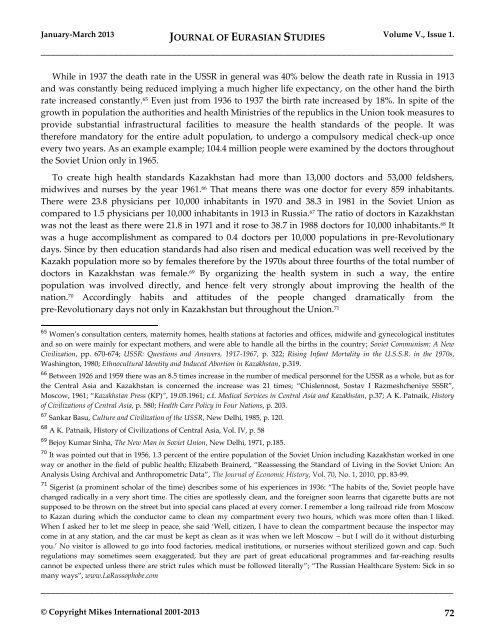JOURNAL OF EURASIAN STUDIES Journal of the Gábor Bálint de ...
JOURNAL OF EURASIAN STUDIES Journal of the Gábor Bálint de ...
JOURNAL OF EURASIAN STUDIES Journal of the Gábor Bálint de ...
Create successful ePaper yourself
Turn your PDF publications into a flip-book with our unique Google optimized e-Paper software.
January-March 2013 <strong>JOURNAL</strong> <strong>OF</strong> <strong>EURASIAN</strong> <strong>STUDIES</strong> Volume V., Issue 1.<br />
_____________________________________________________________________________________<br />
While in 1937 <strong>the</strong> <strong>de</strong>ath rate in <strong>the</strong> USSR in general was 40% below <strong>the</strong> <strong>de</strong>ath rate in Russia in 1913<br />
and was constantly being reduced implying a much higher life expectancy, on <strong>the</strong> o<strong>the</strong>r hand <strong>the</strong> birth<br />
rate increased constantly. 65 Even just from 1936 to 1937 <strong>the</strong> birth rate increased by 18%. In spite <strong>of</strong> <strong>the</strong><br />
growth in population <strong>the</strong> authorities and health Ministries <strong>of</strong> <strong>the</strong> republics in <strong>the</strong> Union took measures to<br />
provi<strong>de</strong> substantial infrastructural facilities to measure <strong>the</strong> health standards <strong>of</strong> <strong>the</strong> people. It was<br />
<strong>the</strong>refore mandatory for <strong>the</strong> entire adult population, to un<strong>de</strong>rgo a compulsory medical check-up once<br />
every two years. As an example example; 104.4 million people were examined by <strong>the</strong> doctors throughout<br />
<strong>the</strong> Soviet Union only in 1965.<br />
To create high health standards Kazakhstan had more than 13,000 doctors and 53,000 feldshers,<br />
midwives and nurses by <strong>the</strong> year 1961. 66 That means <strong>the</strong>re was one doctor for every 859 inhabitants.<br />
There were 23.8 physicians per 10,000 inhabitants in 1970 and 38.3 in 1981 in <strong>the</strong> Soviet Union as<br />
compared to 1.5 physicians per 10,000 inhabitants in 1913 in Russia. 67 The ratio <strong>of</strong> doctors in Kazakhstan<br />
was not <strong>the</strong> least as <strong>the</strong>re were 21.8 in 1971 and it rose to 38.7 in 1988 doctors for 10,000 inhabitants. 68 It<br />
was a huge accomplishment as compared to 0.4 doctors per 10,000 populations in pre-Revolutionary<br />
days. Since by <strong>the</strong>n education standards had also risen and medical education was well received by <strong>the</strong><br />
Kazakh population more so by females <strong>the</strong>refore by <strong>the</strong> 1970s about three fourths <strong>of</strong> <strong>the</strong> total number <strong>of</strong><br />
doctors in Kazakhstan was female. 69 By organizing <strong>the</strong> health system in such a way, <strong>the</strong> entire<br />
population was involved directly, and hence felt very strongly about improving <strong>the</strong> health <strong>of</strong> <strong>the</strong><br />
nation. 70 Accordingly habits and attitu<strong>de</strong>s <strong>of</strong> <strong>the</strong> people changed dramatically from <strong>the</strong><br />
pre-Revolutionary days not only in Kazakhstan but throughout <strong>the</strong> Union. 71<br />
65 Women’s consultation centers, maternity homes, health stations at factories and <strong>of</strong>fices, midwife and gynecological institutes<br />
and so on were mainly for expectant mo<strong>the</strong>rs, and were able to handle all <strong>the</strong> births in <strong>the</strong> country; Soviet Communism: A New<br />
Civilization, pp. 670-674; USSR: Questions and Answers, 1917-1967, p. 322; Rising Infant Mortality in <strong>the</strong> U.S.S.R. in <strong>the</strong> 1970s,<br />
Washington, 1980; Ethnocultural I<strong>de</strong>ntity and Induced Abortion in Kazakhstan, p.319.<br />
66 Between 1926 and 1959 <strong>the</strong>re was an 8.5 times increase in <strong>the</strong> number <strong>of</strong> medical personnel for <strong>the</strong> USSR as a whole, but as for<br />
<strong>the</strong> Central Asia and Kazakhstan is concerned <strong>the</strong> increase was 21 times; “Chislennost, Sostav I Razmeshcheniye SSSR”,<br />
Moscow, 1961; “Kazakhstan Press (KP)”, 19.05.1961; c.f. Medical Services in Central Asia and Kazakhstan, p.37; A K. Patnaik, History<br />
<strong>of</strong> Civilizations <strong>of</strong> Central Asia, p. 580; Health Care Policy in Four Nations, p. 203.<br />
67 Sankar Basu, Culture and Civilization <strong>of</strong> <strong>the</strong> USSR, New Delhi, 1985, p. 120.<br />
68 A K. Patnaik, History <strong>of</strong> Civilizations <strong>of</strong> Central Asia, Vol. IV, p. 58<br />
69 Bejoy Kumar Sinha, The New Man in Soviet Union, New Delhi, 1971, p.185.<br />
70 It was pointed out that in 1956, 1.3 percent <strong>of</strong> <strong>the</strong> entire population <strong>of</strong> <strong>the</strong> Soviet Union including Kazakhstan worked in one<br />
way or ano<strong>the</strong>r in <strong>the</strong> field <strong>of</strong> public health; Elizabeth Brainerd, “Reassessing <strong>the</strong> Standard <strong>of</strong> Living in <strong>the</strong> Soviet Union: An<br />
Analysis Using Archival and Anthropometric Data”, The <strong>Journal</strong> <strong>of</strong> Economic History, Vol. 70, No. 1, 2010, pp. 83-99.<br />
71 Sigerist (a prominent scholar <strong>of</strong> <strong>the</strong> time) <strong>de</strong>scribes some <strong>of</strong> his experiences in 1936: “The habits <strong>of</strong> <strong>the</strong>, Soviet people have<br />
changed radically in a very short time. The cities are spotlessly clean, and <strong>the</strong> foreigner soon learns that cigarette butts are not<br />
supposed to be thrown on <strong>the</strong> street but into special cans placed at every corner. I remember a long railroad ri<strong>de</strong> from Moscow<br />
to Kazan during which <strong>the</strong> conductor came to clean my compartment every two hours, which was more <strong>of</strong>ten than I liked.<br />
When I asked her to let me sleep in peace, she said ‘Well, citizen, I have to clean <strong>the</strong> compartment because <strong>the</strong> inspector may<br />
come in at any station, and <strong>the</strong> car must be kept as clean as it was when we left Moscow – but I will do it without disturbing<br />
you.’ No visitor is allowed to go into food factories, medical institutions, or nurseries without sterilized gown and cap. Such<br />
regulations may sometimes seem exaggerated, but <strong>the</strong>y are part <strong>of</strong> great educational programmes and far-reaching results<br />
cannot be expected unless <strong>the</strong>re are strict rules which must be followed literally”; “The Russian Healthcare System: Sick in so<br />
many ways”, www.LaRussophobe.com<br />
_____________________________________________________________________________________<br />
© Copyright Mikes International 2001-2013 72

















